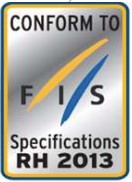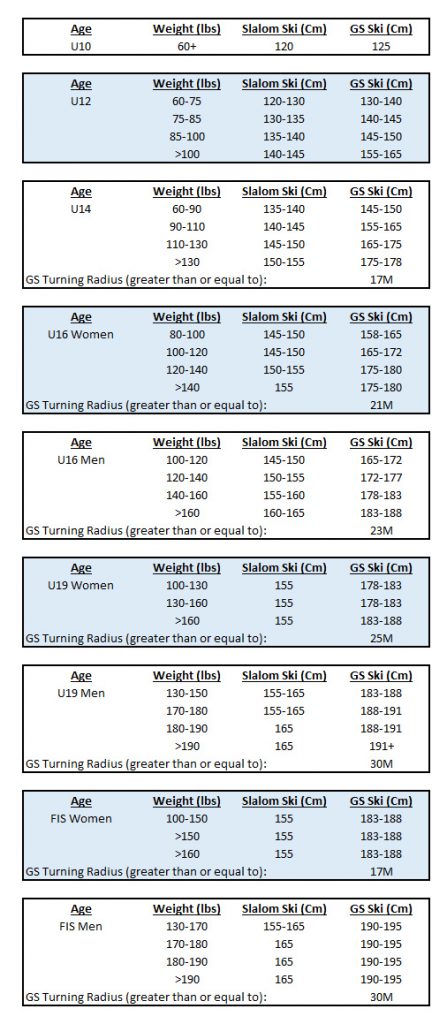Racers should be equipped with the right racing equipment to aid in their skiing development as well as to ensure proper fit and performance. Below are some suggestions to help parents and racers select the appropriate equipment.
New for 2024/2025, Alpine Ontario has worked in collaboration with Skiis and Bikes to provide a guide for ski racing equipment. Click here to view the guide.
Boots
All racers should consult with their coaches as well as certified boot fitters from ski shops. Many of the better ski shops will employ boot fitters that have taken specialized courses to ensure that skiers are using the proper equipment. This is extremely important for ski racers. Make sure to identify your racer to the boot fitter so that they are aware of the racing requirements. Do not size ski boots like you would shoes or regular boots. In general, racing boots should:
- Be sized and fitted by a certified boot fitter.
- Be snug.
- Leave some space for toes to wiggle.
- Shins should not rotate in the cuff of the boat.
- Ankles should be secure.
- Typical boot flex for racers U14 and below range from 60-90 depending on the skiers weight. Racers should be careful not to get boots that are too stiff. This will severely impact their skiing development.
Helmets
Helmets are mandatory for all ski racers during training and racing. Helmets must be designed and labelled for alpine skiing. For racers U14 and above, look for the FIS sticker below on the helmet. Here are some guidelines for helmet selection:

You may be required to go to a specialty ski store to find ski racing helmets. Not all sporting goods stores that sell skis carry ski racing helmets.
- The helmet must have a hard shell covering the ears. This is the most noticeable difference between race helmets and recreational skiing helmets that typically have soft ear covers.
- The helmet must have a smooth surface, no protrusions or any mounts that support cameras or other devices. A slalom face guard connection is permitted but please note that slalom face guards are only permitted in certain age and racing circumstances. See the AOA equipment guidelines for more details.
- The helmet must have a snug fit and there should be no pressure points.
- The helmet should not droop or slide down over the racers eyes.
- Chin straps must be functional.
- Goggles should fit inside the face frame of the helmet.
Ski Racing Poles
Ski racing poles come in multiple types and also vary wildly in prices depending on the type as well as quality. Younger racers will have one set of poles while older racers may have 2-3 different types of poles depending on the type of training and racing. Like everything else, proper size and fit of the ski poles is important. Here are some recommendations:
- For racers U12 and younger, one set of ski racing poles should be fine. Select straight poles. In general, the appropriate length can be determined by having the racer stand straight, in shoes and measure from the ground to half way between their naval and their sternum.
- We do not recommend one brand over another, but here is a handy ski pole length calculator: https://www.leki.com/uk/pole-length-advisor/
- For racers U14 and older, many will have Slalom ski poles (straight) and GS ski poles (curved/angled). Note that GS poles can be sized using the guidelines above and add 5+cm to the length.
Pole Guards
Pole guards protect a racer’s hands in the event that they are “cross blocking” (hitting) slalom poles coming down the race course. In general, racers below U12 will not require pole guards. In fact, many U12 racers (and clubs) do not wear pole guards either. The reason is that for some racers pole guards can cause them to lean over or twist to hit gates which can lead to poor racing form. Please speak with your coach for your racer’s specific recommendations.
Shin Guards
Racing Shin Guards are designed to protect a ski racer’s shins as they hit gates coming down a Slalom (or Kombi) race course. They come in various sizes (junior/adult) and can, in some cases, be cut for a better fit. In general U8 and U10 racers will not require shin guards for racing. U12 racers, depending on their ability, may start using them. Please speak with your coach for your racer’s specific recommendations.
Ski Racing Suits/Snow Jackets and Pants/Training Shorts
Ski Racing Suits are not permitted for racers in the U8-U10 age groups. Please dress your young racers in proper Snow Jackets and Snow Pants to ensure proper warmth. For U12 and above ages, ski racing suits are permitted. Racing suits will improve a racer’s aerodynamics as they train or race. Most racers will wear high quality tops and bottoms underneath to aid in warmth. Look for specially designed winter wear for proper warmth underneath your race suit. For race suits in general, there are many manufacturers that provide suits depending on the type of race. In terms of size and fit, the race suit should feel snug and a particular focus should be on the racers weight. The racer’s height should be taken into account next but be aware that race suits do stretch considerably. Most race suits should cover the top 2 buckles of the ski boot (although some racers will prefer less of the boot covered). There are many race suits for sale on the used market. Training shorts are used frequently by racers on non-race days. Typically these are used to keep them warm as they are riding the chair lift or during regularly training sessions. The race suit will be worn and the training shorts are worn on top of the race suit. This permits the racer to use their shin guards properly.
Ski Sizing Guide
Please use this handy table to determine the most appropriate ski length for your racer. As racers move through the various age categories for racing, ski size and type requirements become more specialized. Please refer to the Alpine Ontario/Skis and Bikes Gear Guide document for more specific informaton regarding ski sizing. This table is only a rough guide.

- U8/U10/U12. Racers only require one set of skis. Using a GS style ski is usually the best overall choice. Some U12 racers may move towards using a dedicated Slalom set of skis and a Giant Slalom (GS) set of skis.
- U14 and above racers will have 2 pairs of skis (and sometimes more). One set for Slalom and one set for GS. The main difference between the skis is turning radius and length.
- FIS racers will have more stringent requirements for their ski types and sizes.
U8/U10 Equipment Guidelines
- All participants must wear a racing approved helmet. Race helmets must have a hard shell over the ears. See the notes in the Helmets section above.
- Racers only need a single pair of straight ski poles.
- Speed suits are not permitted. Racers should wear proper winter clothing for the conditions including ski jackets and snow pants.
- Racers only need one pair of skis.
- Extra mitts and clothing suitable to the weather conditions (i.e. wet snow, rain, etc.).
U12 Equipment Guidelines.
- All participants must wear a racing approved helmet. Race helmets must have a hard shell over the ears. FIS approved helmets are suggested. See the notes in the Helmets section above.
- Racers may wear speedsuits.
- Please check with your coach if pole guards and shin guards are necessary.
- Only one pair of skis are required. However, some U12 racers will have 2 pairs (one for Slalom and one for GS races).
- Only one pair of ski poles are required. However, some U12 racers will have 2 pairs (one for Slalom and one for GS races).
- Side zipped ski pants and/or ski shorts. These can be beneficial for racers as they wait in line for their race at the start hut or during training.
U14 Equipment Guidelines.
- All participants must wear FIS approved helmets. See the notes in the Helmets section above. Consider having 2 helmets if you plan on using a face guard since attaching and removing the face guard could be a regular occurrence.
- Racers may wear speedsuits.
- Please check with your coach if pole guards and shin guards are necessary. In general most racers should have both. In addition, many slalom racers will use face guards and potentially a mouth guard to protect their teeth.
- Slalom face guards may not be worn on helmets for GS or SG training or racing.
- Slalom pole guards may not be worn for GS or SG training or racing.
- Most racers will have 2 pairs of skis. One for Slalom and one for GS races.
- Most racers will have 2 pairs of ski poles. One for Slalom and one for GS races.
- Side zipped ski pants and/or ski shorts. These can be beneficial for racers as they wait in line for their race at the start hut or during training.
U16 & U18/FIS Equipment
- FIS compliant and labelled helmet are required to be worn in training and racing at all times.
- Athletes should have both Slalom and GS specific skis. See the ski selection charts above.
- Slalom and Giant Slalom poles are recommended.
- Shin guards and pole guards are recommended for slalom training and racing.
- Face guards on your racing helmet are recommended for slalom training and racing.
- Some racers may find it more convenient to have two helmets (Slalom and GS) to avoid having to install or remove the slalom face guard depending upon the training and/or racing schedule – very often both events are trained/raced on the same weekend.
- Mouth guards are recommended for slalom racing and training.
- Slalom face guards are not permitted on helmets for GS or SG training or racing.
- Slalom Pole guards are not permitted on helmets for GS or SG training or racing.
- Back protectors/armor are required for Speed Training and Racing – please contact your coach to find out if the the team has these available for you if you choose to participate in those events.